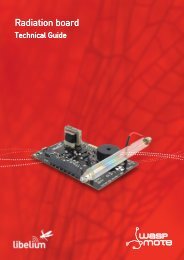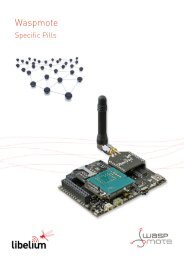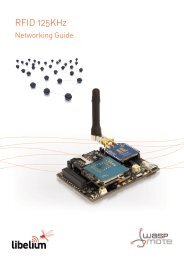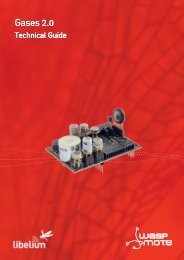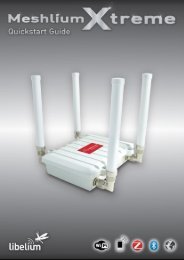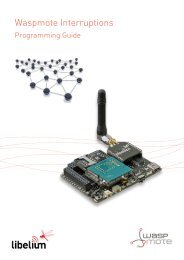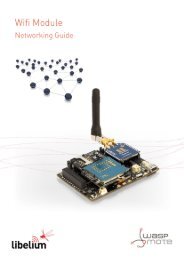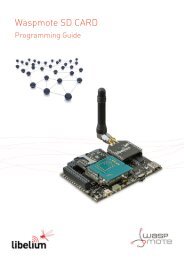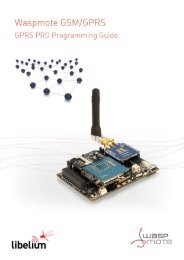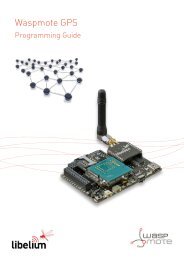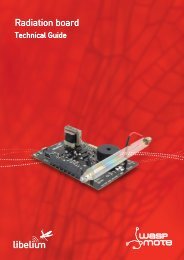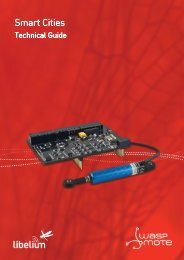Smart Parking Sensor - Libelium
Smart Parking Sensor - Libelium
Smart Parking Sensor - Libelium
You also want an ePaper? Increase the reach of your titles
YUMPU automatically turns print PDFs into web optimized ePapers that Google loves.
IndexDocument version: v4.1 - 04/2013© <strong>Libelium</strong> Comunicaciones Distribuidas S.L.INDEX1. General.................................................................................................................................................. 41.1. General and safety information...............................................................................................................................................41.2. Conditions of use..........................................................................................................................................................................42. Waspmote Plug & Sense!...................................................................................................................... 52.1. Features............................................................................................................................................................................................52.2. <strong>Sensor</strong> Probes.................................................................................................................................................................................52.3. Solar Powered................................................................................................................................................................................62.4. Programming the Nodes............................................................................................................................................................72.5. Radio Interfaces.............................................................................................................................................................................82.6. Program in minutes......................................................................................................................................................................92.7. Data to the Cloud..........................................................................................................................................................................92.8. Meshlium Storage Options.....................................................................................................................................................102.9. Meshlium Connection Options............................................................................................................................................102.10. Models.........................................................................................................................................................................................112.10.1. <strong>Smart</strong> <strong>Parking</strong>.............................................................................................................................................................123. Hardware............................................................................................................................................. 133.1. General Description..................................................................................................................................................................133.2. Specifications..............................................................................................................................................................................133.3. Electrical Characteristics..........................................................................................................................................................133.4. Assembling...................................................................................................................................................................................144. <strong>Sensor</strong> ................................................................................................................................................. 164.1. Specifications..............................................................................................................................................................................164.2. Measurement Process..............................................................................................................................................................165. Board configuration and programming........................................................................................... 185.1. Application considerations....................................................................................................................................................185.1.1. Deployment of the motes........................................................................................................................................185.1.2. Interference of other vehicles.................................................................................................................................205.1.3. Variation of the reference value.............................................................................................................................205.1.4. Determination of the state of the spot................................................................................................................205.1.5. Network structure.......................................................................................................................................................205.2. Installation of the mote...........................................................................................................................................................245.3. Powering the mote....................................................................................................................................................................335.3.1. Battery options.............................................................................................................................................................335.3.2. Estimated lifetime.......................................................................................................................................................345.4. API....................................................................................................................................................................................................345.5. Example code..............................................................................................................................................................................37-2- v4.1
6. Consumption...................................................................................................................................... 406.1. Table of consumption...............................................................................................................................................................407. API Changelog.................................................................................................................................... 418. Documentation changelog................................................................................................................ 429. Maintenance....................................................................................................................................... 4310. Disposal and recycling..................................................................................................................... 44Index-3- v4.1
General1. General1.1. General and safety information••In this section, the term “Waspmote” encompasses both the Waspmote device itself and its modules and sensor boards.••Read through the document “General Conditions of <strong>Libelium</strong> Sale and Use”.••Do not allow contact of metallic objects with the electronic part to avoid injuries and burns.••NEVER submerge the device in any liquid.••Keep the device in a dry place and away from any liquid which may spill.••Waspmote consists of highly sensitive electronics which is accessible to the exterior, handle with great care and avoidbangs or hard brushing against surfaces.••Check the product specifications section for the maximum allowed power voltage and amperage range and consequentlyalways use a current transformer and a battery which works within that range. <strong>Libelium</strong> is only responsible for the correctoperation of the device with the batteries, power supplies and chargers which it supplies.••Keep the device within the specified range of temperatures in the specifications section.••Do not connect or power the device with damaged cables or batteries.••Place the device in a place only accessible to maintenance personnel (a restricted area).••Keep children away from the device in all circumstances.••If there is an electrical failure, disconnect the main switch immediately and disconnect that battery or any other powersupply that is being used.••If using a car lighter as a power supply, be sure to respect the voltage and current data specified in the “Power Supplies”section.••If using a battery in combination or not with a solar panel as a power supply, be sure to use the voltage and current dataspecified in the “Power supplies” section.••If a software or hardware failure occurs, consult the <strong>Libelium</strong> Web Development section.••Check that the frequency and power of the communication radio modules together with the integrated antennas areallowed in the area where you want to use the device.••Waspmote is a device to be integrated in a casing so that it is protected from environmental conditions such as light, dust,humidity or sudden changes in temperature. The board supplied “as is” is not recommended for a final installation as theelectronic components are open to the air and may be damaged.1.2. Conditions of use••Read the “General and Safety Information” section carefully and keep the manual for future consultation.••Use Waspmote in accordance with the electrical specifications and the environment described in the “Electrical Data”section of this manual.••Waspmote and its components and modules are supplied as electronic boards to be integrated within a final product. Thisproduct must contain an enclosure to protect it from dust, humidity and other environmental interactions. In the event ofoutside use, this enclosure must be rated at least IP-65.••Do not place Waspmote in contact with metallic surfaces; they could cause short-circuits which will permanently damage it.Further information you may need can be found at: http://www.libelium.com/development/waspmoteThe “General Conditions of <strong>Libelium</strong> Sale and Use” document can be found at:http://www.libelium.com/development/waspmote/technical_serviceAcknowledgement:<strong>Libelium</strong> wants to thank to the Network Planning and Mobile Communications Group from the University of Cantabria on behalf ofthe <strong>Smart</strong> Santander project who contributed to the testing and performance improvement of the sensor board.-4- v4.1
Waspmote Plug & Sense!2. Waspmote Plug & Sense!The new Waspmote Plug & Sense! line allows you to easily deploy wireless sensor networks in an easy and scalable way ensuringminimum maintenance costs. The new platform consists of a robust waterproof enclosure with specific external sockets toconnect the sensors, the solar panel, the antenna and even the USB cable in order to reprogram the node. It has been speciallydesigned to be scalable, easy to deploy and maintain.Note: For a complete reference guide download the “Waspmote Plug & Sense! Technical Guide” in the Development section ofthe <strong>Libelium</strong> website.2.1. Features••Robust waterproof IP65 enclosure••Add or change a sensor probe in seconds••Solar powered with internal and external panel options••Radios available: Zigbee, 802.15.4, Wifi, 868MHz, 900MHz and 3G/GPRS••Over the air programming (OTAP) of multiple nodes at once••Special holders and brackets ready for installation in street lights and building fronts••Graphical and intuitive programming interface2.2. <strong>Sensor</strong> Probes<strong>Sensor</strong> probes can be easily attached by just screwing them into the bottom sockets. This allows you to add new sensingcapabilities to existing networks just in minutes. In the same way, sensor probes may be easily replaced in order to ensure thelowest maintenance cost of the sensor network.Figure 1: Connecting a sensor probe to Waspmote Plug & Sense!-5- v4.1
Waspmote Plug & Sense!2.3. Solar PoweredBattery can be recharged using the internal or external solar panel options.The external solar panel is mounted on a 45º holder which ensures the maximum performance of each outdoor installation.Figure 2: Waspmote Plug & Sense! powered by an external solar panelFor the internal option, the solar panel is embedded on the front of the enclosure, perfect for use where space is a majorchallenge.Figure 3: Internal solar panel-6- v4.1
Waspmote Plug & Sense!Figure 4: Waspmote Plug & Sense! powered by an internal solar panel2.4. Programming the NodesWaspmote Plug & Sense! can be reprogrammed in two ways:The basic programming is done from the USB port. Just connect the USB to the specific external socket and then to the computerto upload the new firmware.Figure 5: Programming a node-7- v4.1
Waspmote Plug & Sense!Over the Air Programming is also possible once the node has been installed. With this technique you can reprogram wirelesslyone or more Waspmote sensor nodes at the same time by using a laptop and the Waspmote Gateway.Figure 6: Typical OTAP process2.5. Radio InterfacesModel Protocol Frequency txPower Sensitivity Range *XBee-802.15.4-Pro 802.15.4 2.4GHz 100mW -100dBm 7000mXBee-ZB-Pro ZigBee-Pro 2.4GHz 50mW -102dBm 7000mXBee-868 RF 868MHz 315mW -112dBm 12kmXBee-900 RF 900MHz 50mW -100dBm 10KmWifi 802.11b/g 2.4GHz 0dBm - 12dBm -83dBm 50m-500mGPRS - 850MHz/900MHz/1800MHz/1900MHz2W(Class4) 850MHz/900MHz,1W(Class1) 1800MHz/1900MHz-109dBm3G/GPRS - Tri-Band UMTS2100/1900/900MHzQuad-Band GSM/EDGE,850/900/1800/1900 MHz* Line of sight, Fresnel zone clearance and 5dBi dipole antenna.UMTS 900/1900/2100 0,25WGSM 850MHz/900MHz 2WDCS1800MHz/PCS1900MHz 1W-106dBm-8- v4.1
Waspmote Plug & Sense!2.6. Program in minutesIn order to program the nodes an intuitive graphic interface has been developed. Developers just need to fill a web form inorder to obtain the complete source code for the sensor nodes. This means the complete program for an specific applicationcan be generated just in minutes. Check the Code Generator to see how easy it is at:http://www.libelium.com/development/plug_&_sense/sdk_and_applications/code_generatorFigure 7: Code Generator2.7. Data to the CloudThe <strong>Sensor</strong> data gathered by the Waspmote Plug & Sense! nodes is sent to the Cloud by Meshlium, the Gateway router speciallydesigned to connect Waspmote sensor networks to the Internet via Ethernet, Wifi and 3G interfaces.Thanks to Meshlium’s new feature, the <strong>Sensor</strong> Parser, now it is easier to receive any frame, parse it and store the data into a localor external Data Base.Figure 8: Meshlium-9- v4.1
Waspmote Plug & Sense!2.8. Meshlium Storage OptionsFigure 9: Meshlium Storage Options• Local Data Base• External Data Base2.9. Meshlium Connection OptionsFigure 10: Meshlium Connection Options• ZigBee → Ethernet• ZigBee → Wifi• ZigBee → 3G/GPRS-10- v4.1
Waspmote Plug & Sense!2.10. ModelsThere are some defined configurations of Waspmote Plug & Sense! depending on which sensors are going to be used. WaspmotePlug & Sense! configurations allow to connect up to six sensor probes at the same time.Each model takes a different conditioning circuit to enable the sensor integration. For this reason each model allows to connectjust its specific sensors.This section describes each model configuration in detail, showing the sensors which can be used in each case and how toconnect them to Waspmote. In many cases, the sensor sockets accept the connection of more than one sensor probe. See thecompatibility table for each model configuration to choose the best probe combination for the application.It is very important to remark that each socket is designed only for one specific sensor, so they are not interchangeable.Always be sure you connected probes in the right socket, otherwise they can be damaged.ABCDEFFigure 11: Identification of sensor sockets-11- v4.1
Waspmote Plug & Sense!2.10.1. <strong>Smart</strong> <strong>Parking</strong><strong>Smart</strong> <strong>Parking</strong> allows to detect available parking spots by placing the node under the pavement. It works with a magneticsensor which detects when a vehicle is present or not. Waspmote Plug & Sense! can act as a repeater for a <strong>Smart</strong> <strong>Parking</strong> node.Figure 12: <strong>Smart</strong> <strong>Parking</strong> enclosure<strong>Sensor</strong> sockets are no used for this model.-12- v4.1
Hardware3. Hardware3.1. General DescriptionThe Waspmote’s <strong>Smart</strong> <strong>Parking</strong> Board principle of operation is based on the variation of the magnetic field above the boardcaused by the chassis of a vehicle placed on the parking lot where the mote has been deployed. This change is detected using apermalloy magnetic field sensor (MFS), a material whose electric resistance varies with the magnetic field through it, measuredand processed to provide the system with an answer that can be used to determine the state of the parking spot.3.2. SpecificationsWeight: 20grDimensions: 73.5 x 51 x 1.3 mmTemperature Range: [-20ºC, 65ºC]Figure 13: Upper sideFigure 14: Image of the Z axis sensor3.3. Electrical CharacteristicsBoard Power Voltages: 5V<strong>Sensor</strong> Power Voltages: 5VMaximum admitted current (continuous): 200mAMaximum admitted current (peak): 400mA-13- v4.1
Hardware3.4. AssemblingThe MFS includes a module attached perpendicularly to the board, utilized to monitor the vertical axis (Z axis) of the magneticfield. Every board is prepared to operate with one single module, so it is important to maintain the correspondence betweenthem, as it is to maintain the relationship between the board and the Waspmote, prepared for the temperature compensationof a single given board. All the boards, modules and Waspmotes are tagged to allow their identification. In the images belowthe assembling process is shown.Figure 15: Image of the <strong>Smart</strong> <strong>Parking</strong> board, the Z axis sensor and the corresponding Waspmote with the labels highlightedFigure 16: Image of the <strong>Smart</strong> <strong>Parking</strong> board with the Z axis sensor attached-14- v4.1
HardwareFigure 17: Image of the complete system 2. <strong>Sensor</strong>-15- v4.1
<strong>Sensor</strong>4. <strong>Sensor</strong>4.1. SpecificationsThree axis magnetic field sensorMaximum Supply Voltage: 12VOperation Temperature: -40 ~ 125ºCBridge Resistance: 600 ~ 1200ΩTypical Output Voltage: 3,5mV/V/gaussAverage consumption: 15mAMaximum consumption (peak): 500mA4.2. Measurement ProcessThe MFS basically consists of a thin film of permalloy whose resistance is a function of the magnetic field through it (intensity andorientation). This film is integrated in a Wheatstone bridge of resistance between 600Ω and 1200Ω (typically 850Ω), thus betweenthe two output terminals of the sensor we have a voltage in the order of the 3,5mV/V/gauss with a supply voltage of 5V.Since the MFS is a three axis sensor it allows to monitor the magnetic field in any spatial direction. The output of each of the axisis amplified using an instrumentation amplifier and filtered to prevent glitches caused by external magnetic fields. The outputsof the three axis are directly read with the Waspmote’s microprocessor’s analog-to-digital converter in the analog input pinsANALOG1, ANALOG2 and ANALOG5.To read the outputs it is enough with executing the commands read<strong>Parking</strong> or read<strong>Parking</strong>SetReset from the board’slibrary, in which the analog voltage in the input of the analog-to-digital converter is captured. In the second of these functionsa small current pulse (500mA of peak, one microsecond wide) is applied to an internal circuit before reading the sensor so themolecules of the permalloy film are realigned with the magnetic field, eliminating non-desired effects owed to the hysteresisof the material.The board also incorporates a temperature sensor with the purpose of compensating the effects that this parameter has on thesensor. The output of the sensor at pin ANALOG7 can be read using the function readTemperature, assigning its output to aninteger variable. Regarding the temperature compensation, <strong>Libelium</strong> facilitates the sensors calibrated for an operating rangebetween 0º and 45º, with the parameters necessary to calculate the reference in function of the new temperature stored in theEEPROM memory of the mote.Below, the resulting graphs of two different applications are shown. In figure 16 the output of one axis sampled once every10ms appears, with one car entering and leaving the spot twice. In figure 17 the outputs of the three axis sampled every 10seconds are shown. In this case we can see four different vehicles entering and leaving the lot.-16- v4.1
<strong>Sensor</strong>Figure 18: Image of one of the axis of the MFS sampled every 10msFigure 19: Image of the outputs of the three axis of the MFS sampled every 10 secondsMore information about the functions of the library, as long as an example code for reading the sensors, can be found in section“API” of this guide.-17- v4.1
5. Board configuration and programming5.1. Application considerations5.1.1. Deployment of the motesBoard configuration and programmingThe optimum deployment point will be the one where the probability of detection is maximum, which means minimizing theprobabilities of false detection (caused by other vehicles or objects near the lot under control) and false rejection (owed to a nothigh enough variation in the magnetic field above the mote with a vehicle parked in the spot).This optimum deployment spot will depend on the kind of parking lot that we are going to monitor. In the case of parallelparking lots the mote should be deployed below one of the car sides, as shown in figure 20, while for perpendicular parkingspots the most adequate place will be the one nearest to the center of the motor or the backside of the vehicle (see figure 21).Figure 20: Diagram of the deployment points of the motes for parallel parking lots-18- v4.1
Board configuration and programmingFigure 21: Diagram of the deployment points of the motes for perpendicular parking lotsFigure 22: Placement options of the motes for parallel parking lotsFigure 23: Placement options of the motes for perpendicular parking lotsOther consideration to be taken into account in mote deployment is the communication between this one and the gateway orrouter that will receive the data and process or redirect it. This is a very variable issue that will have to be analyzed independentlyfor each scenario.-19- v4.1
Board configuration and programming5.1.2. Interference of other vehiclesAs pointed in section “Deployment of the motes”, the presence of other vehicles in contiguous spots or near places may influencein the detection, modifying the detection threshold. This influence earns special importance in perpendicular lots, where thedistance between the mote and the contiguous vehicles is shortest, and in the non-delimited parallel lots. The best way to avoidthis disturbance is to take into account the state of the near spots in the detection decision when the variation in the magneticfield is very close to the detection threshold.5.1.3. Variation of the reference valueOwing to the variation of the environmental conditions (such as temperature, presence of external fields or small changes in themagnetic field of the earth) the reference value from which the state of the lot is determined doesn’t remain constant, but showsa small oscillation that must be eliminated to maintain the reliability of the system. In the case of the small variations owed tothe hysteresis of the permalloy under parasitic magnetic fields, the sensor is endowed with a readjustment system that permitsto realign the molecules of the permalloy film with the present magnetic field through a small current pulse. In the case of theerror for variations in the temperature of the sensor, <strong>Libelium</strong> supplies the sensors calibrated for an operation range between 0ºand 45º approximately, so this alteration can be compensated through a degree two approximation that updates the referencevalue in function of the measured temperature in the moment of determining the magnetic field.5.1.4. Determination of the state of the spotThe influence of external factors mentioned before make more difficult to make a decision about the state of the spot in the moteitself, lacking the information about the environmental conditions, such as the presence of vehicles in contiguous lots, which maylead to errors in the estimation. Owing to this, it may be advisable to carry out the calculation of the state of the spot on the routersor gateways which collect the information from all the motes at a zone. This entails an increase in the radio-frequency transmissionsfrom the sensor motes, which involves a decrease of the battery’s life. Given the wide casuistry of this kind of applications, a deepstudy of the conditions of the location will be necessary to assure this procedure is necessary.5.1.5. Network structureThere are two possible Network topologies depending on the frequency and protocol used:• 2.4GHz - Multihop ZigBee/Digimesh• 868/900MHz Direct Accessa) 2.4GHz - Multihop ZigBee/Digimesh NetworkWith this frequency band we need to use Waspmote nodes acting as repeaters in the nearby street lights. Once they get theinformation they send using multihop topology to Meshlium, the Gateway of the network.In order to communicate at this frequency band the high power module version (100mW) is recommended.- 1st Step (Figure 24): The nodes send the information to the repeaters.- 2nd Step (Figure 25): The repeaters perform multihop routing and send the information to Meshlium.- 3rd Step (Figure 26): Meshlium sends the information to the Internet using the Wifi or GPRS radio.-20- v4.1
Board configuration and programmingFigure 24: 2.4 GHz - Multihop ZigBee / Digimesh Network - The motes send the information to the repeatersFigure 25: 2.4 GHz - Multihop ZigBee / Digimesh Network - The repeaters send the data using a multihop topology-21- v4.1
Board configuration and programmingFigure 26: 868 / 900 MHz Direct Access Network - The Gateway sends the data to the InternetFigure 27: Meshlium: the ZigBee Internet Gatewayb) 868/900MHz - Direct Access NetworkWith this frequency band we can send directly the data from Waspmote to the Gateway located in the same street.--1st Step (Figure 28): The nodes send the information to Meshlium, the Gateway of the network.--2nd Step (Figure 29): Meshlium sends the information to the Internet using the Wifi or GPRS radio.-22- v4.1
Board configuration and programmingFigure 28: 868 / 900 MHz Direct Access Network - The nodes send directly the data to the GatewayFigure 29: 868 / 900 MHz Direct Access Network - The Gateway sends the data to the Internet-23- v4.1
Board configuration and programming5.2. Installation of the mote<strong>Parking</strong> detection applications require a casing with more restrictive characteristics than other wireless sensor networksapplications, owing to the need of lasting for a long time buried in asphalt, where they must resist the entry of water, owing tothe possibility of puddles of water formed above it, and high pressures on it caused by vehicles parked or driven upon.<strong>Libelium</strong> includes a PVC casing compliant with the IP-67 and IK-10 standards that may be installed in any environment of thischaracteristics.Besides, <strong>Libelium</strong> provides a special non-conductive gel to avoid any damage caused by corrosion, humidity and badenvironmental conditions. This gel is made of a two component silicone which becomes solid when these two components aremixed.Next to these lines, a few recommendations are given in order to ensure right installation procedures, avoiding bad environmentalconditions which can affect the Waspmote enclosure and the electronic equipment inside. Try to follow next steps carefully toachieve a right installation.Important: Before installation, make sure enough tests have been performed in order to achieve a 100% functional codeand that all the necessary information related to the mote, such as identification numbers or XBee MAC addresses, has beencompiled and stored, since once the mote is installed, the access to it will be very limited. Be sure to add in your code a delay(or the possibility to make calibration using an external command) before calibration processes in order to carry out the caseinstallation without affecting the sensor calibration (see section “Example code” for a complete example of calibration). Owing tothis, it is highly recommended to carry out the gel preparation in the deployment location to minimize the battery consumptionbefore operation.Moreover, Gel manipulation is simple and must be done just before placing the parking case in its final location.The necessary elements for one complete parking node are:1. 1 x Waspmote + <strong>Smart</strong> <strong>Parking</strong> board + Communication module2. 1 x non rechargeable battery3. 1 x PVC casing4. Gel packs: component A bottles + component B bottles (see note below) *5. 2 x pink filling foam3 4512Figure 30: Necessary elements for a parking node-24- v4.1
Board configuration and programming* Note: Each enclosure needs 650 ml of mixed gel to cover all electronic parts sensitive to humidity, that means 325ml of component Aand 325ml of component B. However, gel is sold in packs of 500 ml (250 ml of component A + 250 ml of component B) so please checkif yo have enough gel for all of your parking motes. Next table shows necessary gel depending how many motes are you planning toinstall.Number of <strong>Parking</strong> motesNecessary packs1 22 33 44 65 710 1320 26Once you have checked all necessary elements, next steps must be followed.Step 1: Making a hole into pavement.Use a hole saw or other dedicated tool to drill a hole into the pavement bigger enough for the PVC case. Try to perforate it deepenough to bury the mote completely without rising over the asphalt surface but trying to keep the top of the case as up aspossible in order to have the best RF signal possible.Figure 31: Making a hole into pavementFigure 32: Final pavement hole-25- v4.1
Board configuration and programmingH = 150 mmh = 135 mmHhDdmax. heightusable heightmax. diameterusable diameterd = 100 mmD = 121 mmFigure 33: Diagram of dimensions of the caseStep 2: Put Waspmote inside PVC enclosureWhen Waspmote is placed into the parking enclosure, battery should be placed in the dedicated hole in the pink filling foam,taking care that the mote rests in horizontal position and with the antenna in vertical position.IMPORTANT: Remember to stick the filling foam to the enclosure. Otherwise it will float when adding the protective gel.Figure 34: Preparing the sticking foam-26- v4.1
Board configuration and programmingFigure 35: Sticking foam to enclosureFigure 36: Placing Waspmote after sticking foamStep 3: Mix the gelGel is prepared by mixing the two components (A and B) in a 1:1 proportion in a vessel. Use a graduated recipient like shown infigures below to ensure you add the exactly required quantities. For one parking mote 650 ml of mixed gel are needed, thereforeyou should add 325 ml of component A and 325 ml of component B. Stir the mixture for a while ensuring the components arecompletely mixed, since it will not become solid otherwise. Once an homogeneous and without bubbles medley is got, pourcarefully into the casing.Figure 37: Mixing the two gel components-27- v4.1
Board configuration and programmingFigure 38: Ensure they are completely mixed and without bubblesStep 4: Turn Waspmote ONEnsure that Waspmote has the desired code and that it is switched ON before pouring the gel.Step 5: Fill enclosure with gelThe gel should fill all space of the enclosure till Waspmote and the <strong>Smart</strong> <strong>Parking</strong> board are completely covered. Pay specialattention till cover the <strong>Smart</strong> <strong>Parking</strong> Board sensor. This process will ensure protection against water, moisture and badenvironmental conditions (see figures below to ensure you add the right quantity of gel). Be sure to include the pink filling foamto ensure that the provided gel is enough to cover all the electronic parts. Also be sure pink foam is firmly stuck to the enclosure,otherwise it could drift when gel is added, which would move Waspmote to a bad position.Moreover, it is highly recommended to carry out the gel preparation in the deployment location to minimize the batteryconsumption before operation.Figure 39: Fill parking enclosure with the mixture-28- v4.1
Board configuration and programmingFigure 40: <strong>Parking</strong> enclosure with the mixtureStep 6: Close PVC enclosureAfter the gel is poured, close the PVC enclosure firmly.Step 7: Place enclosure into pavement holeBe sure that the enclosure remains under pavement line but no more than one centimeter. Following images show the motebefore and after the installation.Gel<strong>Smart</strong> <strong>Parking</strong> boardWaspmotePink filling foamsNon rechargeable batteryFigure 41: Internal diagram of a parking nodeFigure 42: Image of a mote installed in a perpendicular parking lot-29- v4.1
Board configuration and programmingStep 8: Fixing enclosure to pavementNow, the PVC enclosure has to be fixed to the pavement using Epoxy resin (commonly used for filling road fissures). This resinshould fill all the space between enclosure and pavement and also should cover completely the top of the enclosure, ensuringprotection against water, bad environmental conditions and vandalism.Figure 43: Fixing enclosure to pavementWATEREPOXYPAVEMENTFigure 44: Epoxy filling. (Good installation)WATERWATERPAVEMENTFigure 45: No filling. (Bad installation)-30- v4.1
Board configuration and programmingStep 9: Recommended <strong>Parking</strong> node calibrationOnce the node is placed into the pavement, it needs to be calibrated while the parking spot is empty. Use a laptop with agateway connected to communicate with the parking mote and start calibration process.Figure 46: Node calibration with an empty spotTo communicate with the node, a serial monitor should be used: Hyperterminal in Windows, Realterm in Mac or Cutecom inLinux are some examples. In this guide, Waspmote IDE serial monitor will be used. To use it, just open the IDE, select serial portwhere the Waspmote Gateway is connected and open the serial monitor.Uploading a code into Waspmote like the provided in section “Example code”, next communication sequence would be carriedout for node calibration.1. After the node is turned on, it sends to the gateway a command asking for calibration and it enters in a waiting loop. Seefigure 47.2. Once the node is installed and the spot is empty, a command is sent from the serial monitor which controls the gatewayto start calibration process in this node ( this command will depend on the used XBee module and its configuration, and alsohow data reception is done in the code. For example code provided on section “Example code”, any data packet coming from anetwork node is valid to start the node calibration). See figure 483. The node starts calibration process and it answers when calibration is done. Answer is shown in serial monitor. See figure 49.4. Once the node has been calibrated, it sends periodically the normal operation commands. See figure 50.Next four figures are screenshots which match with each described step.WASPMOTE IDE SERIAL MONITORSENDINGWINDOWRECEIVINGWINDOWRECEIVED COMMAND FROM SPOT 1Figure 47: Step 1. Receiving SPOT 1 command asking for calibration-31- v4.1
Board configuration and programmingSEND CALIBRATIONSTART COMMANDFigure 48: Step 2. Sending calibration start commandNEW RECEIVED COMMAND FROM SPOT 1Figure 49: Step 3. Receiving commad to ensure calibration is doneRECEIVIED COMMANDS FROMSPOT 1 IN NORMAL OPERATIONFigure 50: Step 4. Normal operation SPOT 1 commandsIt is recommended to test deeply this part before final installation, to ensure node remains well calibrated and ready for a goodoperation. Ask in <strong>Libelium</strong> technical forum in our website if you have questions about how to use parking API functions.-32- v4.1
Board configuration and programming5.3. Powering the moteSince the mote in a parking monitoring application will be buried underground with no access to a system to recharge thebattery, it is recommended to use a battery with the highest capacity available to extend as much as possible the life of thedevice. Under these conditions, <strong>Libelium</strong> recommends the utilization of one of the two Lithium non-rechargeable batteriesdescribed in next section (to obtain more information about them please contact <strong>Libelium</strong>’s sales department at commercial@libelium.com).5.3.1. Battery options<strong>Libelium</strong> provides two different Lithium non-rechargeable batteries for powering Waspmote in parking applications:••Battery of 26Ah••Battery of 52AhMain differences between them are battery capacity and self discharge current. Next pictures show both possibilities.Figure 51: Image of the 26Ah batteryFigure 52: Image of the 52Ah battery-33- v4.1
Board configuration and programming5.3.2. Estimated lifetimeThis section describes estimated lifetime for a parking application in which the state of the spot is measured every five minutesand transmitted via XBee Digimesh 2.4GHz and 868MHz.Consumption table:XBee Digimesh 2.4GHz XBee RF 868MHzSleep Time and consumption 298.1 seconds, 64μA 297.3 seconds, 64μAMeasurement time and consumption 380 miliseconds, 33mA 380 miliseconds, 33mATransmission time and consumption 1.52 seconds, 72mA 2.32 seconds, 90.5mAComplete cycle average consumption 0.470mA 0.805mABattery lifetime estimation table:XBee Digimesh 2.4GHz XBee RF 868MHz26Ah battery approximate self discharge current 88μA 88μA52Ah battery approximate self discharge current 176μA 176μA26Ah battery estimated lifetime 5.3 years 3.3 years52Ah battery estimated lifetime 9.1 years 6.0 years5.4. APIThe functions to handle all the features of the board, included in the Wasp<strong>Sensor</strong><strong>Parking</strong> API library, are detailed below. Thefunctions necessary to control the state of the spot in all kind of situations have been implemented, but take into account that notall of them will be needed in all the situations:Library values:••Compensation coefficients: this library includes those coefficients, in floating point format, necessary to estimate thecompensation for the temperature variation using the function calculateReference. These coefficients are uniquefor each sensor board, are stored in the Waspmote’s EEPROM memory and can be read using the function loadReference.The list of the names of the coefficients is shown below:--coefX2--coefY2--coefZ2--coefX--coefY--coefZ--constX--constY--constZ••<strong>Sensor</strong>s’ initial values: after carrying out the calibration of the initial state of the parking lot the values read from themagnetic field and temperature sensors are stored in four integer variables that will be used to calculate the reference ofthe magnetic field for every measurement:--initialX--initialY--initialZ--initialT-34- v4.1
Board configuration and programming••<strong>Sensor</strong>s’ read values: the values of the sensors read in the execution of functions read<strong>Parking</strong> or read<strong>Parking</strong>SetResetare stored in three integer variables that will be used to estimate the state of the spot:--valueX--valueY--valueZ••<strong>Sensor</strong>s’ reference values: after executing the calculateReference function the result is stored in three integervariables that contain the reference for each of the three sensors on the board.--referenceX--referenceY--referenceZ••<strong>Sensor</strong>s’ compensation indexes: from the calibration temperature and the compensation coefficients three indexes, onefor each sensor, that will be used in the calculation of the sensor’s reference are extracted and stored as floating pointvariables.--indexX--indexY--indexZ••THRESHOLD: defined as a constant instead of a variable, it defines the threshold used in function estimateState todetermine the state of the parking lot. In case its value is to be modified, it must be done in the file Wasp<strong>Sensor</strong><strong>Parking</strong>.hof the library.Reserved Memory Zone:A zone of the EEPROM memory of the microcontroller between addresses 186 and 222 has been reserved to store the coefficientsused in temperature compensation. Under no circumstances should this zone of the memory be overwritten, as long as itcould lead to an irreparable error in most applications.When using the <strong>Smart</strong> <strong>Parking</strong> <strong>Sensor</strong> Board on Waspmote PRO, remember it is mandatory to include the <strong>Sensor</strong><strong>Parking</strong> libraryby introducing the next line at the beginning of the code:#include Library functions:• <strong>Sensor</strong><strong>Parking</strong>.ON()Turns on the sensor board by activating the 5V supply line.• <strong>Sensor</strong><strong>Parking</strong>.OFF()Turns off the sensor board by cutting the 5V supply line.• <strong>Sensor</strong><strong>Parking</strong>.setBoardMode(MODE)The setBoardMode function of this board activates or deactivates completely the supply voltage of the board assigning thevalues SENS_ON or SENS_OFF to the parameter MODE. In the case of the parking detection board only the 5V power supply isused, and all the electronics contained in it, included the sensors, are turned on or off using this function.• <strong>Sensor</strong><strong>Parking</strong>.calibration()This function calculates the initial values of magnetic field for each of the three sensors in the empty parking lot, which arestored in variables initialX, initialY and initialZ, and the compensation indexes of each sensor from the temperaturemeasured in that moment, staying those values stored in variables indexX, indexY and indexZ.-35- v4.1
Board configuration and programming• <strong>Sensor</strong><strong>Parking</strong>.loadReference()In those applications that require temperature compensation this function loads the compensation coefficients stored in theEEPROM memory, characteristic of a specific parking board, in the variables mentioned before.• <strong>Sensor</strong><strong>Parking</strong>.calculateReference(TEMPERATURE)The calculateReference function is used in applications that require temperature compensation to update the referencevalue in function of the current temperature of the mote. It utilizes the values stored in variables initialX, initialY,initialZ, indexX, indexY, indexZ, the compensation coefficients and the temperature, introduced in Celsius degree asan integer variable through the parameter TEMPERATURE, returning the new values in variables referenceX, referenceYand referenceZ.• <strong>Sensor</strong><strong>Parking</strong>.read<strong>Parking</strong>()The read<strong>Parking</strong> function is used to read the output of each of the sensors at the input of the microcontroller’s analog-todigitalconverter. When it is executed the voltage values at the analog inputs of the three sensors (ANALOG1, ANALOG2 andANALOG5) are captured and stored in variables valueX, valueY and valueZ respectively.• <strong>Sensor</strong><strong>Parking</strong>.read<strong>Parking</strong>SetReset()The function behaves in a very similar way to the former one, with the only difference that this one applies a current pulse inthe internal circuit of every sensor to realign the molecules of the permalloy film, as indicated in section “Measurement Process”.• <strong>Sensor</strong><strong>Parking</strong>.readTemperature()The temperature sensor attached to the <strong>Smart</strong> <strong>Parking</strong> board can be read through the readTemperature function that,with the purpose of obtaining a more accurate measurement, averages eight captures of the voltage value at the analog pincorresponding to the sensor output (ANALOG7). The value is returned in Celsius degree as an integer variable.• <strong>Sensor</strong><strong>Parking</strong>.estimateState()This function uses the values read from the sensors and stored in variables valueX, valueY and valueZ and the referencevalues calculated with the function to estimate the state of the spot, returning a boolean variable (‘1’ in the case of an occupiedspot, ‘0’ in the case of an empty one). This calculation consists of a comparison between the difference between the value readfrom each sensor and its respective reference and a threshold stored in constant THRESHOLD. In the case any of these differencessurpasses given threshold, the lot will be considered occupied.-36- v4.1
Board configuration and programming5.5. Example codeWe provide below with a code suitable for a simple parking detection application. Take into account that depending on theconditions of the application a more complex calculation in the decision of the state of the lot may be necessary./* ------------<strong>Smart</strong> <strong>Parking</strong> <strong>Sensor</strong> Board example---------------www.<strong>Libelium</strong>.com*/// Inclusion of the Frame library#include // Inclusion of the <strong>Smart</strong> <strong>Parking</strong> <strong>Sensor</strong> Board v20 library#include // Inclusion of the XBee Digimesh library#include // Sleep time between measures#define SLEEP_TIME “00:00:00:05”// Variable to store temperatureint temperature;// Variable to store statusboolean status;// Gateway address#define ADDRESS “0013A2004070DA3E”packetXBee* packet;int error;void setup(){///////////////////////////////////////////////////////// STEP 1 /////////////// Turn On XBee and wait calibration command /////////////////////////////////////////////////// Turn ON the XBee Digimesh modulexbeeDM.ON();delay(1000);packet=(packetXBee*) calloc(1,sizeof(packetXBee)); // memory allocationpacket->mode=UNICAST; // set Unicast mode// Send a broadcast message of “awaiting calibration” commandxbeeDM.setDestinationParams(packet, ADDRESS, “SPOT1 Awaiting calibration command\n\r”,MAC_TYPE);do{error = xbeeDM.sendXBee(packet);}while( error );free(packet);packet = NULL;// Note: Code hangs here until an answer is received.The user can// add here his own command and also its own waiting period, etc.Utils.setMuxXBEE();delay(100);while( xbeeDM.available() == 0 )-37- v4.1
Board configuration and programming{}// Turn off the XBee Digimesh modulexbeeDM.OFF();delay(100);///////////////////////////////////////////////////////// STEP 2 ////////////// Calibration process. ////////////////////////////////////////////////// Once “start calibration” command is received, calibration starts.<strong>Sensor</strong><strong>Parking</strong>.loadReference();<strong>Sensor</strong><strong>Parking</strong>.ON();delay(100);<strong>Sensor</strong><strong>Parking</strong>.calibration();<strong>Sensor</strong><strong>Parking</strong>.OFF();// Send a broadcast message with calibrated valuesxbeeDM.ON();delay(1000);packet=(packetXBee*) calloc(1,sizeof(packetXBee)); // memory allocationpacket->mode=UNICAST; // set Broadcast mode// Create new frame (ASCII) with the sensor dataframe.createFrame(ASCII,”Waspmote_Pro”);frame.add<strong>Sensor</strong>(SENSOR_STR, “SPOT1 initial values”);frame.add<strong>Sensor</strong>(SENSOR_MF, <strong>Sensor</strong><strong>Parking</strong>.initialX, <strong>Sensor</strong><strong>Parking</strong>.initialY, <strong>Sensor</strong><strong>Parking</strong>.initialZ);}xbeeDM.setDestinationParams( packet, ADDRESS, frame.buffer, frame.length);do{error = xbeeDM.sendXBee(packet);}while( error );xbeeDM.OFF();free(packet);packet = NULL;void loop(){///////////////////////////////////////////////////////// STEP 3 ////////////// Normal operation: Measurement ////////////////////////////////////////////////// Turn on the board<strong>Sensor</strong><strong>Parking</strong>.ON();delay(100);// Read the sensors<strong>Sensor</strong><strong>Parking</strong>.read<strong>Parking</strong>SetReset();temperature = <strong>Sensor</strong><strong>Parking</strong>.readTemperature();// Estimate the state and turn off the board<strong>Sensor</strong><strong>Parking</strong>.calculateReference(temperature);status = <strong>Sensor</strong><strong>Parking</strong>.estimateState();<strong>Sensor</strong><strong>Parking</strong>.OFF();-38- v4.1
Board configuration and programming///////////////////////////////////////////////////////// STEP 4 ////////////// Data Transmission and sleep ////////////////////////////////////////////////// Create new frame (ASCII) with the sensor dataframe.createFrame(ASCII,”Waspmote_Pro”);frame.add<strong>Sensor</strong>(SENSOR_MF, <strong>Sensor</strong><strong>Parking</strong>.valueX, <strong>Sensor</strong><strong>Parking</strong>.valueY, <strong>Sensor</strong><strong>Parking</strong>.valueZ);frame.add<strong>Sensor</strong>(SENSOR_PS, status);}// Turn On XBee and send StatexbeeDM.ON();delay(1000);packet=(packetXBee*) calloc(1,sizeof(packetXBee)); // memory allocationpacket->mode=UNICAST; // set Broadcast modexbeeDM.setDestinationParams( packet, ADDRESS, frame.buffer, frame.length);do{error = xbeeDM.sendXBee(packet);}while( error );xbeeDM.OFF();free(packet);packet = NULL;// Go to sleep.RTC.ON();PWR.deepSleep(SLEEP_TIME,RTC_OFFSET,RTC_ALM1_MODE1,ALL_OFF);You can also find a simple test code where the data is printed through the USB port here:http://www.libelium.com/development/waspmote/examples/pa-1-smart-parking-test-example/The files related to this sensor board are: Wasp<strong>Sensor</strong><strong>Parking</strong>.cpp, Wasp<strong>Sensor</strong><strong>Parking</strong>.hThey can be downloaded from: http://www.libelium.com/development/waspmote/sdk_and_applications-39- v4.1
Consumption6. Consumption6.1. Table of consumptionIn the case of the <strong>Smart</strong> <strong>Parking</strong> board, the power supply is only controlled by the general switch of the 5V source in Waspmote,so none of the components will be active once the board has been disconnected, so the consumption in this situation will be null.Board OffBoard On (Average)Board On (Peak)Consumption0μA25mA500mA (1 microsecond)-40- v4.1
API Changelog7. API ChangelogFunction / File Changelog Version#include Remember to include the Wasp<strong>Sensor</strong><strong>Parking</strong> library in the top of your pde V0.31 → v1.0<strong>Sensor</strong><strong>Parking</strong>.ON() New function to turn on the board V0.31 → v1.0<strong>Sensor</strong><strong>Parking</strong>.OFF() New function to turn off the board V0.31 → v1.0PARKING_ADDRESS_COEFX2...PARKING_ADDRESS_CONSTZThough it does not affect regular programming, take into account that theEEPROM addresses in which the calibration coefficients are stored havechanged from 256~292 to 186~222V0.31 → v1.0-41- v4.1
Documentation changelog8. Documentation changelog••Added references to 3G/GPRS Board in section: Radio Interfaces.-42- v4.1
Maintenance9. Maintenance••In this section, the term “Waspmote” encompasses both the Waspmote device itself as well as its modules and sensor boards.••Take care with the handling of Waspmote, do not drop it, bang it or move it sharply.••Avoid putting the devices in areas of high temperatures since the electronic components may be damaged.••The antennas are lightly threaded to the connector; do not force them as this could damage the connectors.••Do not use any type of paint for the device, which may damage the functioning of the connections and closure mechanisms.-43- v4.1
Disposal and recycling10. Disposal and recycling••In this section, the term “Waspmote” encompasses both the Waspmote device itself as well as its modules and sensor boards.••When Waspmote reaches the end of its useful life, it must be taken to a recycling point for electronic equipment.••The equipment has to be disposed on a selective waste collection system, different to that of urban solid waste. Please,dispose it properly.••Your distributor will inform you about the most appropriate and environmentally friendly waste process for the usedproduct and its packaging.-44- v4.1



